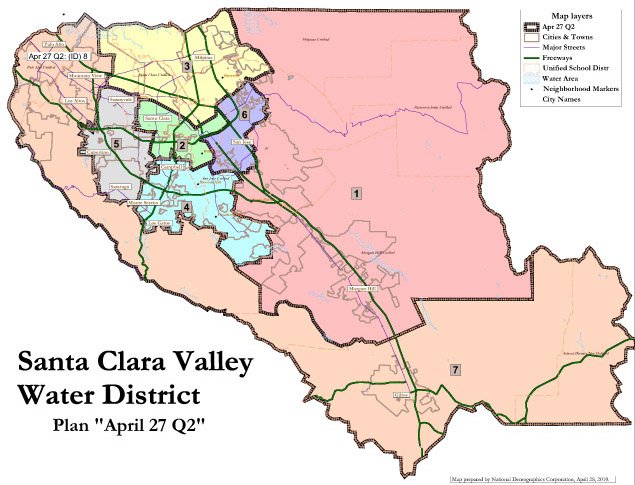An 11th-hour decision by the Santa Clara Valley Water District
to push through a new electoral map that splits Gilroy from Morgan
Hill could come to haunt the agency.
An 11th-hour decision by the Santa Clara Valley Water District to push through a new electoral map that splits Gilroy from Morgan Hill could come to haunt the agency.
Gilroy Mayor Al Pinheiro called an emergency meeting for Monday evening “to entertain litigation against the water district,” he said. The efforts of that pitch were not available by press time. Morgan Hill Mayor Steve Tate said the new boundaries create a situation “without common interest.”
“We were led to believe that there was a political agreement that we could get two seats for South County,” Tate said. “That apparently was not the case.”
Both Tate and Pinheiro sent letters to the water district Friday rescinding their support of splitting South County – a position they originally took after discussions with unnamed water board members, both cities’ chambers of commerce and some members of the public. The new water district map – passed by a 5-1 vote – divides Morgan Hill and San Martin into District 1 with Gilroy linked to Palo Alto and Mountain View in District 7. Pinheiro said he is encouraging other cities to consider challenging the new map.
South County’s at-large director Cy Mann, who replaced retiree Sig Sanchez, voted for the map after the board received letters from Pinheiro, Tate, the Gilroy and Morgan Hill chambers of commerce and Sanchez asking that South County be halved. Yet, the map they endorsed looked nothing like the mayors had hoped, Pinheiro said, because it fuses Palo Alto with Gilroy and not with Los Gatos, for example.
“South County has waited over 30 years to get represented, and now they will be,” said Mann, who is planning to run for the District 1 seat. He said it was time for Morgan Hill and Gilroy to be divided and increase the chances for representation. Mann said he hasn’t seen huge changes that have helped South County with a single Morgan Hill-Gilroy district and pointed to the rising groundwater fees as one piece of evidence.
South County residents pay $275 per acre foot of municipal and industrial use and $16.50 per acre foot of agricultural use. One acre foot can provide water for a family of five for two years. North County residents pay $520 per acre foot of municipal and industrial use.
“I didn’t know that fear existed. I didn’t know Gilroy was so afraid for standing up for itself,” Mann said. “South County wanted two districts – they got two districts. Now it’s not good enough for them? It’s up to Morgan Hill and Gilroy to put their representatives in office. Run for it. Fight for it, for goodness sakes.”
The quick push to vote through the new map has redistricting committee members and county residents calling it “totally politically motivated,” according to Lynda Ramirez Jones, who served on the committee and is a water district retiree.
“It’s really a mess. Those board members need a rude awakening,” Jones said. “They need to be replaced.”
One theory for the directors’ decision is that the water board cut the map the way it did to discourage county Supervisor Don Gage from running for what would have been one South County water board seat, according to committee members, several South County residents and Gage. He has since said he’s reconsidering running because of the inclusion of Palo Alto, which could draw a viable opponent.
“The motivation was Cy Mann wanted to get elected, and he couldn’t do it if there was one district together,” Gage said. “(The board directors) are very comfortable in their districts.”
Gage said the act was “very poor public policy.”
“To put a diverse committee together and do the redistricting, to ignore all the work they did and redraw the maps – they just ignored them.”
Mann retorted to Gage’s reconsideration: “Gilroy’s not worth running for? That’s pathetic,” Mann said. He denies he voted for the split for any reason other than “that’s what South County wanted.”
Now that South County is split, Morgan Hill and San Martin account for about 15 percent of District 1’s population. Gilroy’s 51,000 residents is less than 20 percent of District 7’s population. In a joint South County district, they reaped the benefit of nearly 50 percent representation – including residents on the outskirts – which is why electing a South County person now is going to be a challenge.
“They did what the state and federal government asked and cut their own paths,” Gage said. “Look at the reality there, it’s a sliver on the top of the mountain that reaches all the way up north. There’s 190,000 people up there – 50,000 in Gilroy.”
A strong candidate from Palo Alto could easily pick up the needed votes, Gage said.
Pinheiro said the letter that he and Tate sent on behalf of Gilroy and Morgan Hill stated that they did not agree with the way the district was drawn.
“Obviously as far as South County is concerned, it was always South County’s intention in a legal way to have a better chance to have two South County representatives,” Pinheiro said.
South County has had two representatives dating back to 1986, when the Gavilan Water District had one before it was dissolved into an “at-large” position at the SCVWD.
“From the beginning, we knew the original two seats, we could not have a district which was going to be the old water Gavilan District,” said current District 1 director Rosemary Kamei, who abstained in the map vote. Palo Alto’s current director Patrick Kwok accounted for the single “no” vote.
Kamei said she told the groups who spoke in support of two districts, “‘You know this is going to cause – in terms of population – smaller groups for Morgan Hill and Gilroy,’ I told them that.” They responded with, “‘We’d rather have two chances than one chance,'” Kamei said.
She abstained because although she thought it was important to have two voices on the board from South County and she did not agree with how far north District 7 reached.
“On one testimony, on one day, a minority changed the decision,” ex-county Supervisor Susanne Wilson said, who also served on the committee.
Wilson was inflamed by the decision.
“It’s not sour grapes. The people, I felt, were shortchanged. They got a smaller percentage of the representation,” Wilson said.
“This was all on them,” water district’s staff liaison Rick Callendar said about the directors’ decision. “I was never part of those discussions (about dividing South County). I was unaware of the impetus of what happened.” Callendar said the district was “purely being responsive” to South County’s wishes.
Palo Alto City Manager Jim Keene and Mountain View Mayor Ronit Bryant both sent letters rejecting the board’s decision.
The Santa Clara Farm Bureau encouraged dividing South County to ensure there was at least a possibility for two representatives from the farming communities. Jan Garrod, the president of the Farm Bureau, said he’s not worried about a South County resident not being elected. “Look, it’s not light-years away,” Garrod said. “They’re still going to listen to the people. The people in the community have pretty good access to the district.”
Mann said Morgan Hill needs to be more independently minded and stop looking to the south for the lead on what to do.
“I feel good about what’s been done,” Mann said. “If the people want to be heard, then come on, put your tennis shoes and walk the precincts.”
The districts had to meet the U.S. Supreme Court mandate that each electoral district has equal populations within 10 percent – or about 240,000 residents.
“It’s like sausage making, we have to put everything together and hope that it tastes good to everybody,” Callendar said. “Our board made sausage based on the comments and requests based on everyone. They gave them what they wanted and then they don’t like it.”













